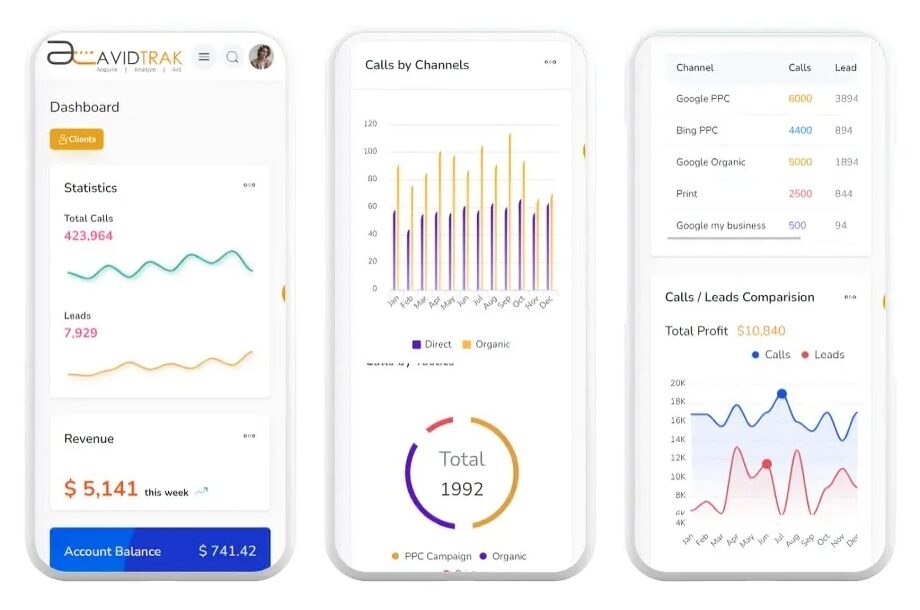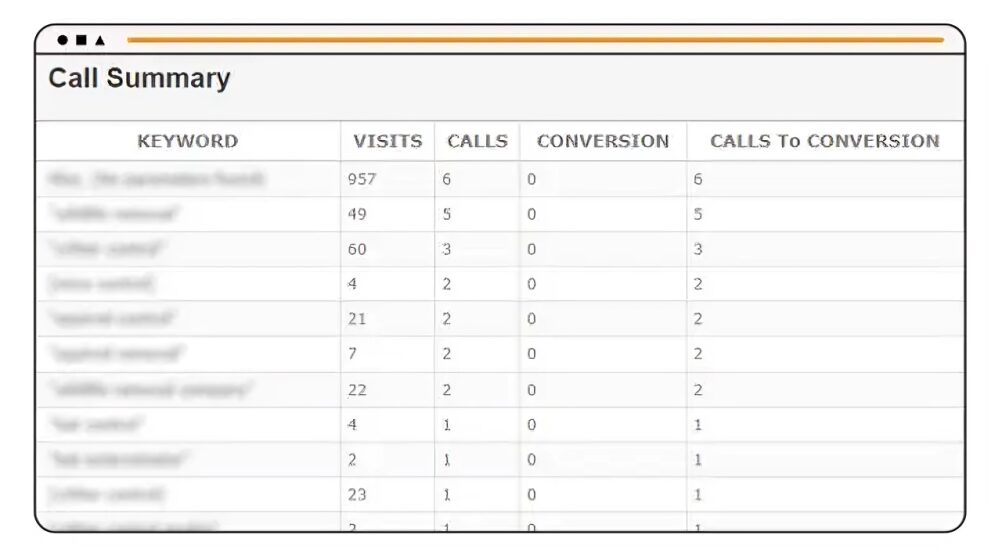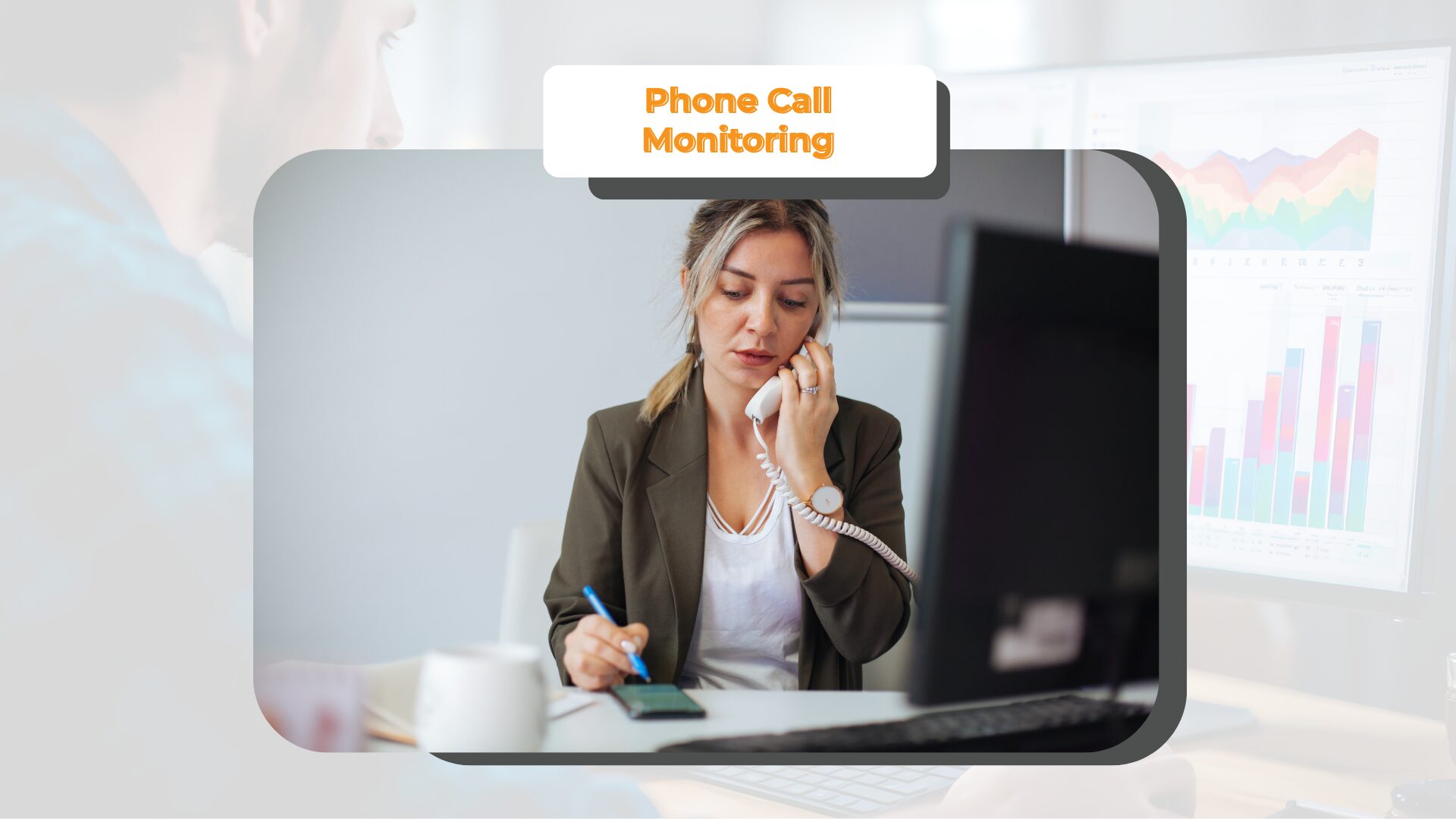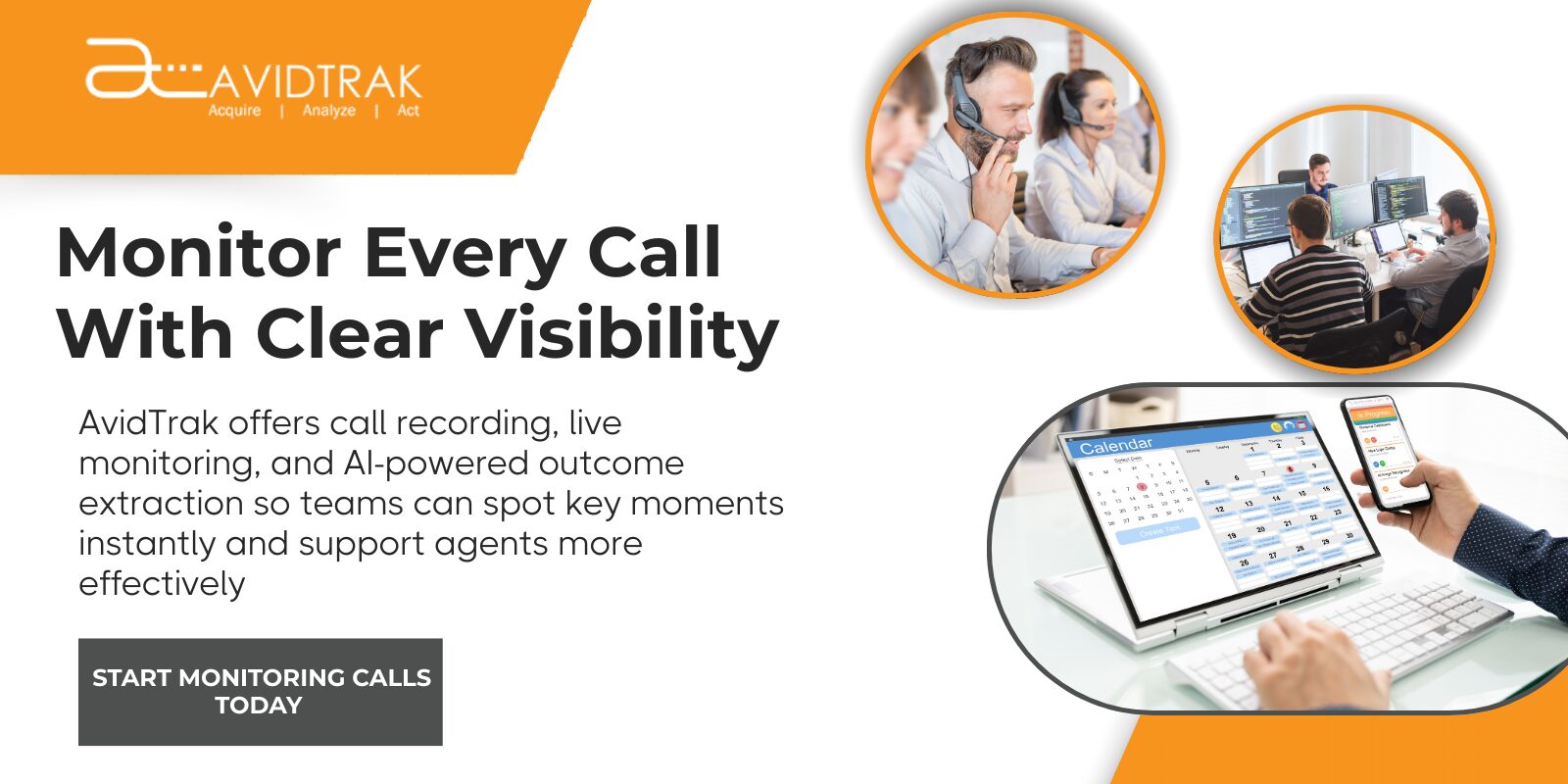Ever wondered why some businesses handle customer calls efficiently while others lose leads and frustrate callers?
A single phone call can make or break a sale, but without the right tools, businesses miss valuable information that could improve service quality, boost sales, and ensure compliance with legal requirements. Call monitoring software is the solution that helps alleviate these issues.
A single conversation can decide whether a prospect becomes a customer. However, without the right tools, valuable details get lost, affecting sales, service quality, and compliance with legal requirements.
Phone call monitoring software solves this by recording, analyzing, and reporting conversations. It allows teams to identify booking or pricing requests through AI-powered transcription and conversation outcome extraction, providing real data for better decisions.
Businesses use these outcomes to plan staffing schedules, adjust ad budgets, and refine landing pages, ensuring every call turns into a measurable opportunity.
In this guide, we’ll break down the different types of call monitoring systems, explain their benefits, and show how businesses can use them effectively.
Summary
- Call monitoring helps businesses improve service, sales, and compliance by tracking and analyzing phone conversations, ensuring every call is handled professionally.
- Different types of call monitoring serve distinct purposes, from live monitoring that enables real-time coaching to automated systems that deliver clear findings without the need for manual review.
- Call monitoring enhances customer satisfaction by reducing missed opportunities and improving response times to solve issues such as long hold times, frequent call transfers, and poor call quality.
- Sales teams benefit from call tracking by spotting trends and maximizing revenue. Business call monitoring helps identify customer objections, refine sales pitches, and recover lost leads.
- Compliance call monitoring ensures businesses meet regulatory standards with secure call recording and automated disclaimers, reducing the risk of legal issues while protecting customer data.
- With AI-powered transcription and conversation outcome extraction, AvidTrak identifies key call moments, such as bookings or pricing discussions, without manual review. AvidTrak combines these AI capabilities with CRM integration and transparent, flat-fee pricing, offering businesses a cost-effective, data-driven approach to call monitoring.
What is Call Monitoring?
Call monitoring is the process of listening to, reviewing, and analyzing business phone conversations to improve service quality and agent performance. It helps businesses track how customer service representatives handle calls, ensuring positive experiences for customers while identifying areas for improvement.
Businesses use call monitoring and recording to improve customer satisfaction levels, provide agent feedback, and maintain compliance with processes.
Sales managers rely on it to uncover valuable sales opportunities and ensure customer interactions lead to a successful sale.
Some of the main goals of call monitoring include:
- Improving Customer Experience: Tracking customer service interactions helps businesses deliver excellent customer service and boost customer satisfaction.
- Agent Training and Performance: Sales teams and customer service agents receive real-time monitoring and coaching to improve customer interactions.
- Quality Assurance and Compliance: Businesses must meet regulatory compliance obligations, follow protection regulations, and maintain privacy standards.
- Boosting Sales and Efficiency: Tracking technology provides a clear analysis of agent interactions through AI-powered call transcripts and conversation outcome extraction, helping businesses identify buying signals and strengthen overall team performance.
By monitoring phone calls, businesses gain a deeper understanding of conversations, allowing them to make service improvements and maintain high standards in daily experiences with customers.
Why Phone Call Monitoring Matters for Businesses
Ever had a customer call go wrong? Maybe a frustrated client didn’t get the answers they needed, or a promising sales lead slipped away.
Call monitoring and recording help businesses detect issues early and apply real improvements. It is not just about listening to calls but using AI-driven analysis, through AI-powered transcription and conversation outcome extraction to strengthen sales performance, enhance service quality, and maintain compliance.
Here is why phone call monitoring matters for businesses:
1. Improving Agent Performance with Feedback & Coaching
Your customer service representatives and sales agents are the face of your business. But how do you know if they’re handling customer interactions the right way?
Real-time monitoring and coaching capabilities allow managers to provide agent feedback instantly. Having an advanced call recording software like AvidTrak helps businesses track performance over time, ensuring that agents follow best practices and improve their service quality.
For example, in dental offices, front desk staff handle a mix of appointment requests, insurance queries, and patient concerns. Call monitoring can highlight service improvements needed, such as reducing hold times or improving how staff explain procedures.
2. Better Customer Satisfaction with Faster Resolutions
A single bad experience can drive customers away.
Call monitoring recording helps analyze conversations to identify problem areas, such as frequent call transfers, long wait times, or poor call quality management.
In law firms, where every client call is important, call recording technologies help lawyers track conversations with potential clients. If a lead is lost due to a missed follow-up, the firm can pinpoint where things went wrong and make adjustments.
3. Reducing Lost Leads and Maximizing Sales Opportunities
How many potential customers call your business but never convert? Tracking technology can help sales teams spot valuable sales opportunities and cross-sell opportunities that might otherwise go unnoticed.
For example, in the insurance industry, call monitoring can help agents improve their sales approach. If customers frequently ask about a specific policy but don’t buy, conversation intelligence can reveal what’s missing in the pitch.
4. Ensuring Compliance with Legal Standards
Businesses must follow regulatory compliance standards, especially when recording calls. Different states and industries have strict regulations for protecting customer interactions. AvidTrak offers advanced monitoring capabilities that help businesses meet compliance requirements while keeping call recordings secure.
In education, schools and tutoring services often record calls for employee training purposes and to track student inquiries. However, they must ensure compliance with processes to protect student privacy. AvidTrak’s cloud-based call recording ensures secure storage and easy access while meeting privacy regulations.
Call monitoring recording is important for all industries as it help you track performance, improve service, and protect your business. The more information that you have from phone calls, the easier it is to train agents, close deals, and keep customers happy.
Types of Call Monitoring
Call monitoring comes in different forms, each serving a unique purpose in improving agent performance, customer experience, and business operations. Here are a few common types of call monitoring:
1. Live Call Monitoring
Managers listen to phone conversations in real-time, allowing them to step in if an issue arises. This is useful for agent training, quality assurance, and ensuring a successful sale.
2. Recorded Call Monitoring
Calls are recorded and stored for later review, helping businesses analyze agent interactions, track performance over time, and ensure compliance. Immutable call recordings also provide proof of compliance requirements.
3. Whisper Monitoring
Call whispering is when supervisors can provide agent feedback during live calls without the customer hearing. This helps agents navigate tough conversations while improving customer service.
4. Barge-In Call Monitoring
When needed, a manager can join an active call, either listening silently or stepping in to help. This is great for escalations, problem resolution, and real-time coaching.
5. Automated Call Monitoring (AI and Analytics)
Using speech analytics technology, AI can scan calls for sentiment analysis, performance improvement opportunities, and compliance with processes. Businesses get actionable outcomes without manually reviewing every call.
Each phone call monitoring method supports business process improvement by helping teams deliver better customer service and extract meaningful findings from every recorded conversation.
AI Outcome Tags: From Signal to Action (NEW)

Modern phone call monitoring goes beyond recording; it interprets intent.
With AI-powered conversation outcome extraction, AvidTrak automatically identifies key signals in each call, such as booking requests, pricing inquiries, or lead qualification discussions. These AI outcome tags convert raw conversation data into a practical direction for your sales and support teams.
Supervisors can create alert rules to decide who gets notified, when, and how. For example, sending an immediate email or SMS alert to the right agent when a pricing inquiry is detected. This approach shortens response times, ensuring the most valuable leads receive prompt attention.
AI outcome extraction, paired with AI-powered transcription, Conversational AI, and Speech Analytics, makes every conversation searchable and measurable. These AI-driven findings allow businesses to prioritize follow-ups, track team performance, plan staffing schedules, and improve customer experience.
How Call Monitoring Works in AvidTrak
A call monitoring system is only effective when it is simple to configure and delivers measurable results.
That’s where AvidTrak adds value. AvidTrak’s call recording quality monitoring system gives businesses complete control over phone conversations, enabling enhanced customer interactions, accurate performance tracking, and compliance with privacy regulations.
AvidTrak’s Call Monitoring Features
AvidTrak offers a wide range of monitoring capabilities, including:
- Live Call Monitoring – Listen to calls as they happen for real-time analysis and agent feedback.
- Recorded Call Monitoring – Review past calls to improve agent onboarding processes and spot performance improvement opportunities.
- Whisper Monitoring – Coach agents during a live call without the customer knowing.
- Barge-In Monitoring – Join a live call when an issue needs immediate attention.
- AI and Analytics – Use speech analytics technology to detect key sentiment analysis triggers, sales opportunities, reasons for calls, and sales call recording patterns.
With an easy-to-use interface, businesses can customize settings to fit their needs – without any additional cost, helping you manage business operations smoothly.
Setting Up Call Monitoring in AvidTrak
AvidTrak’s phone call monitoring recording system is designed for businesses that need effective call recording, real-time monitoring, and coaching capabilities to improve customer interactions.
Setting up AvidTrak’s call monitoring is straightforward, allowing businesses to quickly start tracking agent performance and identifying valuable sales opportunities. Here’s how:
Getting Started with AvidTrak’s Call Monitoring
1. Enable Call Recording
Businesses can activate recording for incoming calls, outbound calls, or specific campaigns. This ensures that every customer service representative follows compliance requirements while helping quality assurance managers maintain service standards.
2. Set Monitoring Permissions
Different teams have different needs. With AvidTrak, businesses can assign monitoring roles to supervisors, allowing them to listen live, provide whisper coaching, or barge into a call when necessary.
This ensures agent onboarding processes include the right training while maintaining customer satisfaction levels with instant escalation and problem resolution.
3. Integrate with Analytics
AvidTrak’s tracking technology integrates seamlessly with Salesforce, HubSpot, Google Ads, and GA-4, ensuring all business systems work together. This integration allows managers to track performance over time, uncover cross-sell opportunities, and improve team performance without relying on guesswork.
4. Customize Alerts for Key Call Events
Supervisors can set up notifications for important business operations triggers. These alerts can notify teams about the following:
- High-value leads detected through speech analysis.
- Frequent call transfers that may indicate poor call quality management.
- Compliance violations, ensuring business owners meet regulatory compliance obligations.
- Missed sales opportunities, helping teams follow up faster and boost sales.
How AvidTrak Helps Improve Call Monitoring Results
Unlike basic manual call quality monitoring, AvidTrak provides conversation intelligence that transforms phone calls into valuable data. Businesses can track customer interactions, monitor agent calls, and make informed decisions based on real statistics.
1. Comprehensive Dashboards for Performance Tracking

AvidTrak’s monitoring capabilities give business owners a deeper analysis of their customer interactions. Businesses can track:
- Agent interactions to measure service improvements and job satisfaction.
- The proportion of calls leading to a successful sale.
- Speech analytics technology to identify trends in chat conversations and actual conversation data.
2. Seamless CRM & Analytics Integration

By connecting AvidTrak with Google Ads, GA-4, Salesforce, and HubSpot, both businesses and marketing agencies can:
- Map agent interactions to specific marketing campaigns and, for agencies, consolidate client data within white-label dashboards for unified visibility across multiple accounts.
- Automate call tracking for customer service representatives, ensuring they follow best practices in business process optimization.
- Store immutable call recordings for business-compliant documentation.
3. Real-Time Reporting and Alerts by AvidTrak

AvidTrak provides detailed, custom call tracking reports that help businesses analyze phone conversations, measure agent performance, and optimize customer interactions. These custom reports go beyond just listing call logs; they deliver actionable findings that improve business operations and team performance.
Here are the types of reports offered by AvidTrak:
- Call Detail Reports – A complete log of all incoming and outgoing calls, including call duration, caller details, and call outcome.
- Keyword-Level Call Tracking Reports – Connects phone calls to specific marketing campaigns to measure valuable sales opportunities and cross-sell opportunities.
- Caller Journey Reports – Shows the full customer experience, from their first website visit to the actual conversation, helping businesses understand how leads convert.
- Call Recording & Transcription Reports – Stores immutable call recordings and provides speech analysis for compliance with processes and agent feedback.
- Geographic Call Tracking Reports – Helps businesses track agent interactions across different locations, ensuring compliance requirements and better business process optimization.
- Call Scoring & Quality Assurance Reports – Allows quality assurance managers to review recording technologies for performance improvement opportunities and better customer service.
With real-time reporting and alerts, businesses no longer need to guess which calls drive successful sales. They gain a clear analysis of customer satisfaction, compliance rates, and sales team performance to guide better decisions.
For agencies, scheduled reports and GA4 / Ads / CRM conversion data make it easier to demonstrate marketing performance to clients without managing day-to-day call operations.
Implementation Checklist (30/60/90)
AvidTrak makes it simple to move from setup to measurable performance. This structured 30/60/90-day rollout plan shows how to implement phone call monitoring effectively while maintaining compliance and visibility across all campaigns.
First 30 Days — Foundation
Begin with essentials: enable call recording with proper disclaimers, confirm caller permissions, and connect AvidTrak to key marketing and CRM systems such as GA4, Google Ads, and Salesforce through third-party integrations.
Set up real-time alerts for new calls and conversation outcomes to ensure prompt follow-ups.
Next 60 Days — Quality and Compliance
Conduct your first QA review using recorded conversations and AI-powered transcription to score performance and identify training needs. Start establishing coaching loops and finalize your call retention policy to align with company data governance standards.
After 90 Days — Optimization
Refine alert rules based on conversation AI conversation outcome tags and agent performance.
Add outcome-based queues that automatically route calls, such as bookings or pricing requests, to the right departments. Publish a monthly report cadence linking call details to staffing plans, keyword attribution to ad budgets, and QA scoring to coaching schedules.
Following this phased plan ensures your business call monitoring setup steps translate directly into improved marketing efficiency, stronger compliance, and better customer engagement across all communication channels.
Best Practices for Effective Call Monitoring
Setting up call monitoring recording is just the first step.
To truly improve customer interactions, boost team performance, and stay business compliant, businesses need a clear strategy. Here are some best practices to make the most of AvidTrak’s monitoring capabilities.
1. Set Clear Goals and Metrics
Tracking calls without a purpose won’t help much. Businesses need to define measurable targets to see real performance improvement opportunities.
It is important to identify areas where calls can be handled faster without sacrificing customer satisfaction levels. Features such as speech analysis and AI-powered sentiment analysis can be used to measure customer experience and pinpoint areas for improvement. Track agent interactions to ensure quality assurance managers have the data they need to improve service.
2. Establish Transparency
If agents feel like they’re being watched without understanding why, job satisfaction and team performance can suffer. The key is to communicate monitoring policies clearly so employees understand how real-time call monitoring and recording benefit both them and the business.
Here is what can be done:
- Explain the purpose
- Encourage open communication among employees
- Use call monitoring for growth, not just for oversight
When businesses are transparent, agents are more likely to embrace monitoring capabilities, leading to a more effective call-recording strategy.
3. Regularly Analyze and Act on Call Data
Call monitoring recording is only useful if businesses take action on what they learn. Using AvidTrak’s real-time reporting and advanced call analytics, businesses can analyze phone calls and make data-driven improvements.
- Use Analytics to Identify Patterns – Track frequent call transfers, long hold times, and poor call quality management to find areas that need attention.
- Schedule Periodic Training Sessions – Use recording calls and agent feedback from previous calls to improve customer service representatives’ performance.
- Address Compliance Gaps – Use compliance call monitoring reports to ensure your business meets legal obligations, especially when operating across different states with varying regulations.
By consistently reviewing tracking technology data, businesses can improve customer service, close more valuable sales opportunities, and ensure every phone conversation is handled efficiently.
AvidTrak makes it easy to get started with call monitoring by offering a free trial and simple, flat-fee pricing with no hidden costs. Businesses don’t have to worry about extra charges for support, integrations, or customizations; everything is included. With affordable pricing and excellent customer support, AvidTrak ensures businesses get the best value while improving their call tracking and monitoring capabilities.
Common Pitfalls and How to Avoid Them
Call monitoring recording is a powerful tool, but if not used correctly, it can create more problems than solutions. Here are some mistakes businesses make and how to avoid them.
Over-Monitoring and Micromanagement
Constantly listening to agent interactions can make employees feel like they’re being watched too closely. This can hurt job satisfaction and lead to lower team performance.
It is important to find the right balance and use agent feedback from recording technologies to improve employee training purposes, not just to point out mistakes.
Ignoring Legal Compliance
Different states have different compliance requirements for recording calls. Some require one-party consent, while others need two-party consent before a phone call can be recorded.
Businesses must follow regulatory compliance obligations within their region to avoid fines and legal risks. Moreover, customers should be informed that their phone conversations may be monitored for quality assurance and protection regulations.
AvidTrak ensures business owners stay compliant with cloud-based call recording, automatic disclaimers, and secure call storage to meet compliance with processes.
Neglecting Follow-Up Action

Simply recording calls isn’t enough. Without acting on outcomes and findings, performance improvement opportunities are wasted, and customer satisfaction levels won’t improve.
- Use Data for Meaningful Changes – Tracking technology can identify poor call quality management, missed sales opportunities, and common customer interaction issues.
- Implement Actionable Training – Managers should review conversation intelligence from AI-powered phone call recording tools and provide targeted agent training sessions.
Regular call recording quality monitoring ensures that your team maintains high service standards and identifies poor audio or connection issues before they impact customer satisfaction.
AvidTrak makes real-time analysis easy with custom reports, speech analytics technology, and PPC tracking, helping businesses turn call monitoring into measurable growth. Start your free trial today and see how AvidTrak transforms every phone conversation into data you can act on.
Frequently Asked Questions
1. Is call monitoring legal?
Legality depends on local consent laws. Some regions require one-party consent, while others require two-party consent. Businesses using call center monitoring software should always play a disclaimer before recording. AvidTrak’s system supports automated announcements to help comply with regulations across hosted VoIP platforms and call center software environments.
2. What is the difference between phone call monitoring and call tracking?
Call monitoring focuses on reviewing conversation quality, agent communication, and performance metrics, while call tracking attributes calls to campaigns, channels, or keywords for marketing analysis. In AvidTrak, call center monitoring tools such as call whisper and call listening features let supervisors guide call center agents in real time, while tracking tools connect each call to its marketing source.
3. How does AI-powered transcription help in call monitoring?
AI technology converts recorded audio into searchable text, enabling faster reviews and training with real customer interactions. Within call center monitoring software, this feature allows supervisors to tag recurring issues, measure performance metrics, and coach call center agents using authentic examples drawn from live calls.
4. What is conversation outcome extraction?
This AI technology identifies call outcomes such as booking confirmations, pricing requests, or qualification discussions. AvidTrak uses AI-powered conversation outcome extraction with its whisper feature to alert teams about high-value leads in real time. These AI-driven outcomes help businesses prioritize follow-ups, evaluate marketing performance, and improve call center monitoring accuracy.
5. Do I need any special hardware?
No. AvidTrak is a cloud-based solution that works with existing phone systems and hosted VoIP platforms. Businesses can monitor, record, and analyze calls without extra equipment, making it easy to manage call center monitoring directly through modern call center software.



